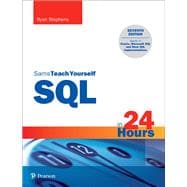Practical, hands-on examples show you how to apply what you learn.
Quizzes and exercises help you test your knowledge and stretch your skills.
Notes and tips point out shortcuts and solutions.
* Clearly understand your data
* Set up databases and plan efficient database designs
* Define entities and relationships, establish data structures, and create database objects
* "Normalize" raw databases into logically organized tables
* Edit relational data and tables and manage transactions
* Write effective, well-performing queries
* Categorize, summarize, sort, group, and restructure data
* Work with dates and times
* Join tables in queries, use subqueries, and combine multiple queries
* Optimize performance with indexes and other techniques
* Administer databases and manage users
* Secure databases and data









